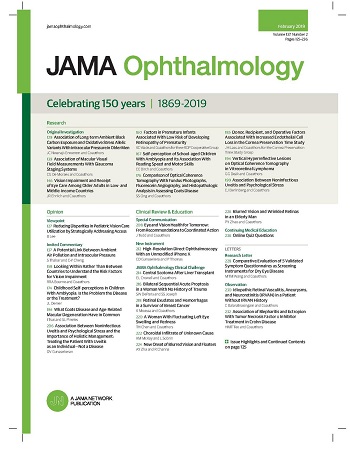Application of Artificial Intelligence to Deliver Healthcare From the Eye.
IF 7.8
1区 医学
Q1 OPHTHALMOLOGY
引用次数: 0
Abstract
Importance Oculomics is the science of analyzing ocular data to identify, diagnose, and manage systemic disease. This article focuses on prescreening, its use with retinal images analyzed by artificial intelligence (AI), to identify ocular or systemic disease or potential disease in asymptomatic individuals. The implementation of prescreening in a coordinated care system, defined as Healthcare From the Eye prescreening, has the potential to improve access, affordability, equity, quality, and safety of health care on a global level. Stakeholders include physicians, payers, policymakers, regulators and representatives from industry, government, and data privacy sectors. Observations The combination of AI analysis of ocular data with automated technologies that capture images during routine eye examinations enables prescreening of large populations for chronic disease. Retinal images can be acquired during either a routine eye examination or in settings outside of eye care with readily accessible, safe, quick, and noninvasive retinal imaging devices. The outcome of such an examination can then be digitally communicated across relevant stakeholders in a coordinated fashion to direct a patient to screening and monitoring services. Such an approach offers the opportunity to transform health care delivery and improve early disease detection, improve access to care, enhance equity especially in rural and underserved communities, and reduce costs. Conclusions and Relevance With effective implementation and collaboration among key stakeholders, this approach has the potential to contribute to an equitable and effective health care system.人工智能在眼部医疗服务中的应用
重要的是,眼组学是一门分析眼部数据以识别、诊断和管理全身性疾病的科学。本文的重点是通过人工智能(AI)分析视网膜图像进行预筛查,以识别无症状个体的眼部或全身性疾病或潜在疾病。在协调的医疗系统中实施预筛查,定义为“从眼睛开始的医疗保健”预筛查,有可能在全球范围内改善医疗保健的可及性、可负担性、公平性、质量和安全性。利益相关者包括医生、支付方、政策制定者、监管机构以及来自行业、政府和数据隐私部门的代表。人工智能眼科数据分析与在常规眼科检查中捕获图像的自动化技术相结合,可以对大量人群进行慢性疾病的预筛查。视网膜图像既可以在常规眼科检查中获得,也可以在眼科护理之外的环境中使用方便、安全、快速和无创的视网膜成像设备获得。这样的检查结果可以以协调的方式在相关利益攸关方之间进行数字沟通,以指导患者进行筛查和监测服务。这种方法提供了机会,可以改变保健服务方式,改进早期疾病检测,改善获得保健的机会,加强公平,特别是在农村和服务不足的社区,并降低成本。结论和相关性通过关键利益相关者之间的有效实施和协作,这种方法有可能有助于建立公平有效的卫生保健系统。
本文章由计算机程序翻译,如有差异,请以英文原文为准。
求助全文
约1分钟内获得全文
求助全文
来源期刊

JAMA ophthalmology
OPHTHALMOLOGY-
CiteScore
13.20
自引率
3.70%
发文量
340
期刊介绍:
JAMA Ophthalmology, with a rich history of continuous publication since 1869, stands as a distinguished international, peer-reviewed journal dedicated to ophthalmology and visual science. In 2019, the journal proudly commemorated 150 years of uninterrupted service to the field. As a member of the esteemed JAMA Network, a consortium renowned for its peer-reviewed general medical and specialty publications, JAMA Ophthalmology upholds the highest standards of excellence in disseminating cutting-edge research and insights. Join us in celebrating our legacy and advancing the frontiers of ophthalmology and visual science.
 求助内容:
求助内容: 应助结果提醒方式:
应助结果提醒方式:


